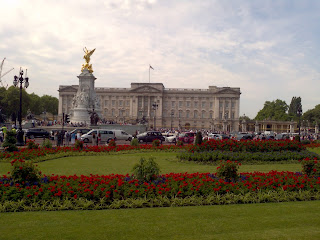BTW- We also learned that the clock tower we all call Big Ben is actually called Elizabeth Tower and the bell inside is called Big Ben - so you can hear it, but not see it!
We also went to Trafalgar Square which has a monument to the 1805 Battle of Trafalgar which is designed to be the height of Admiral Nelson's ship's mast and made with the metal from captured French cannons.
Our tour also took us to the Queen's/King's Guard Museum where the regiment for the changing of the guard at Buckingham Palace is stationed. The King's Guard was established in 1660 by King Charles II as personal protection for the monarch. This was because of the rebellion which led to the execution of his father, King Charles I. Several leaders of the rebellion were military leaders and when he was restored to the throne, King Charles wanted more protection.
Our next stop was to see the changing of the guard at Buckingham Palace. Buckingham Palace was built in 1703 for the Duke of Buckingham and was purchased for Queen Charlotte, wife of King George III, in 1761 because she was looking for a comfortable family residence near St. James Palace where court functions were held. It was known as the Queen's House until Queen Victoria made it the official residence of the the monarch. Monarchs of Great Britain have lived there since including during World War II when it was bombed in 1940.
Our next adventure was a ride in the Underground or "Tube" to find the British Museum. We saw so many artifacts from Mesopotamia, Egypt, Greece, and Rome! We also made a stop at the British Library to see the exhibit on the Magna Carta that included many documents in history that were influenced by the Magna Carta (1215 AD) including the Declaration of Independence and the UN Declaration of Human Rights. We even saw an original copy of the Magna Carta!
We ended our day with a ride on one of the more than 8000 big red buses in London back to the hotel to rest for tomorrow's adventure when we leave the city for the day!
Trafalgar Square Monument
The Queen's Guard marching to Buckingham Palace to change the guard.
Laura and I in front of Buckingham Palace
Buckingham Palace
The Standard of Ur (2600-2400 BC) It was found in one of the largest graves in a royal cemetery in Ur (in Southern Iraq). It has two sides - war depicts the Sumerian Army and peace which depicts a banquet. (You can see the peace side!)
An Egyptian relief sculpture from a tomb.
Look!!! It's the Palette of Narmer!!!!! From the 31st century BC, this slate palette was created to describe the unification of Upper and Lower Egypt into one kingdom.
Yes, that is the REAL Rosetta Stone!!! Look at how big that is!!! The carved text in Greek, Demotic, and Hieroglyphs was the key to unlocking the meaning of ancient Egyptian Hieroglyphic writing.








No comments:
Post a Comment